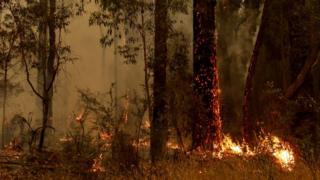 Image copyright Getty Images
Image copyright Getty Images Several readers have asked whether Australia’s famous eucalyptus trees have helped spread the bushfires which have raged for months.
Also known as the gum tree, these forests are some of the most flammable in the world.
How do eucalyptus trees spread fires?
Eucalyptus trees cover more than three-quarters of Australia’s forested area and almost all of the hundreds of species are native to the island nation.
Strips of bark that hang off the trunk and the branches can ignite and carry a fire up the tree and then through the forest spread by the wind.
“When the bark ignites it can be blown great distances, starting new fires,” says Dr Jane Cawson, an expert in vegetation flammability at the University of Melbourne.
This process, called spotting, can ignite 30km (18 miles) ahead of the main fire and is very difficult to suppress.
“The trees themselves exacerbate the fires mostly through spotting,” says Dr Cawson.
Some gum tree leaves contain oil that can also ignite easily and burn quickly.
There is also the vegetation on the floor of a eucalyptus forest, which tends to readily catch fire.
Over time they have adapted to their environment where drought and fires are common, and the trees themselves are usually very resilient.
Some species have developed the ability to survive, and recover, from bushfires and soon resprout through buds that lie dormant.
Burning also releases seeds from their capsules stored in the canopy which can also aid the regeneration process.
However, new research shows that if the same patch of forest is burned by high-intensity fire more than once over a short period of time, which has happened in Australia, even the most resilient species of eucalyptus may struggle to recover.
Is there an alternative to eucalyptus?
These natural forests, often in protected areas, provide a habitat for huge numbers of plant and animal species.
“There is no public discussion [in Australia] about replacing them with alternative species,” says Dr Cawson.
Aboriginal communities have used the tree for a multitude of practical purposes from crafting tools to using the oil as medicine.
However, there are debates about how to look after the forests to prevent fires spreading.
One of these options is prescribed burning, and there has been a political row about whether more of this “controlled burning” as a means to stop fires spreading should have been done.
Other countries have gum trees too
The main species that has been exported and planted widely outside of Australia is the Eucalyptus globulus.
“It’s actually one of the less flammable eucalyptus trees, but it is nevertheless much more flammable than some of the native landcover it has replaced,” says Stefan Doerr, an expert in wildfires at Swansea University.
These trees have contributed to wildfires in California and Portugal, which suffers from some of the worst fires in Europe.
The eucalyptus was regarded as being one of the main reasons fires were so deadly in Portugal in 2017. They are grown for paper across large areas of the central and northern parts of the country.
At the time, an environmental group said the fires reflected a “situation of negligence” and criticised the mass replacement of pine trees with eucalyptus trees.
Elsewhere eucalyptus trees are commonly used for reforesting and commercial purposes because they are fast-growing, despite ecologists warning they can be bad for native species.
These varieties are often bred to be more productive and are much less of a fire hazard, says Fangyuan Hua, a conservation ecologist based at Peking University in China.
“These ‘tree farms’ are typically under fairly careful management which can lower their fire risk,” she said.
Click Here to Visit Orignal Source of Article https://www.bbc.co.uk/news/world-51132965

